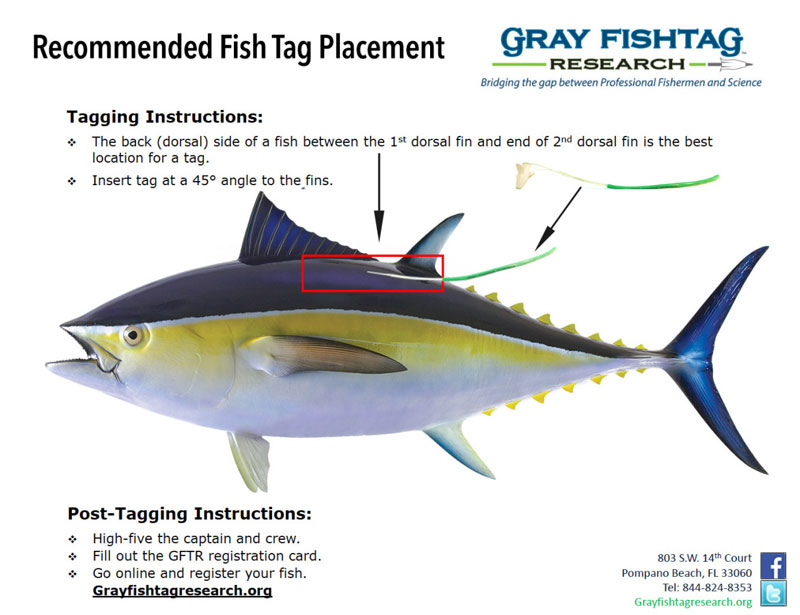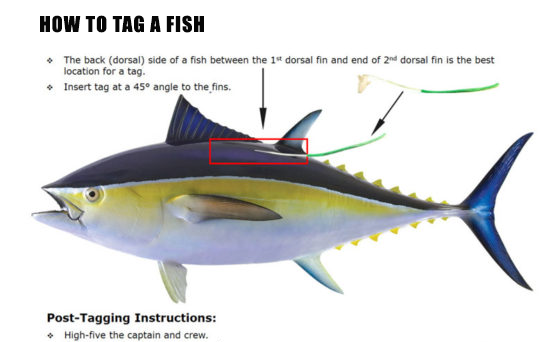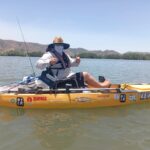How to Properly Tag a Fish
A simple guide to assist you in your tagging efforts
Types of tags
Pelagic tag (A series) – Species over 60cm. Great for Tuna, Mackerel, Dolphinfish and Wahoo, Snapper and Groupers and over 70cm for Kingfish. (Nylon Dart head with bright green Polyolefin tubing.)

Billfish tag (B series) – Marlin, Sailfish, Swordfish and Spearfish only.
(Nylon Dart head with flexible strong double monofilament. Bright green polyolefin tubing.)
How to tag game fish using the billfish and shark tags
Always remember – Successful tagging is a team effort
Billfish and shark tags are designed to lock into muscle tissue on the dorsal area of the fish, well above the lateral line. It is important to insert the tag to the correct depth of ~2.5 inches for the billfish tag and about ~1.9 inches for the shark tag. Shallow or incorrectly placed tags may result in premature tag loss.
Once the angler brings the fish within range, the fish should be traced and led alongside the boat so that it presents a broad tagging target. It is usually best to keep the boat moving slowly forwards to enable better control of the fish.
- As soon as the angler brings the fish within range, the fish should be traced and led alongside the boat so that it presents a broad tagging target and allowing the fish to calm down. It is usually best to keep the boat moving slowly forwards to enable better control of the fish.
- Once the fish is in position to be tagged, the person handling the tag pole should take position behind the person tracing the fish to allow for a clear tag shot.
- An attempt to apply the tag should only be made if the fish is calm or subdued. The tag should be placed towards the middle of the fish, well above the lateral line towards the dorsal fin (See recommended areas above).For billfish and most sportfish, the fish should be tagged with a firm, well-aimed stroke – simply place the tag against the fish’s flank and push. Do not stab. Sharks will require a firm jab in order to penetrate their tough skin.
- Once the tag has been deployed, remove the hook if possible (a de-hooker can facilitate this) or cut the trace close to the fish’s mouth.
- **IMPORTANT** Always make an effort to revive a fish that appear to be exhausted or is struggling to remain upright in the water.A common approach for billfish is to hold the fish firmly by its submerged bill whilst the boat moves forwards at 2 to 3 knots. This ensures a good flow of water over the fish’s gills. Try to continue this practice and release the fish once it shows strong signs of life. Improved skin color is also a good indicator that the fish is getting stronger. This may take several minutes or more. Please use care and caution, especially in rough weather to prevent serious injury to yourself or your fishing partners.
 How to tag game fish using the pelagic tag
How to tag game fish using the pelagic tag
When tagging with the smaller pelagic tag, the majority of fish should be removed from the water before tagging. This improves accuracy of tagging. This technique will also simplify hook removal and allow more accurate recording of the length and weight. For larger fish a short hand tagger can be used for tagging boat side. Try to prevent the fish damaging itself on hard, hot, or dry surfaces. A wet foam mat or similar is ideal for on-boat tagging.
We recommend Pelagic tags to be inserted by a smaller hand tagger or short pole, as they are designed to lock behind the bony structures of the dorsal fin or second dorsal fin in order to remain in position. Carefully insert the tag into the fish’s back, close to the base of the fin and angled in so that it passes through the bony structures that radiate off the fin. Try to insert the tag at an angle of at least 45° to reduce water friction and then twist the tag pole before removing it. In effect, you should be trying to hook the barb of the tag around one of these spines, which then locks the tag in place.
As with all tagging, try to immediately fill out the tag registration card as correctly and completed as possible, and return to Gray FishTag Research as soon as possible for most relevant data.
Estimating the size of the fish
This may be done by estimating the weight of the fish or by measuring the fish when it is in, or alongside the boat. If the fish is up to 3 Ft. in length it may be carefully brought on board and measured using a standard measuring tape. However, large fish should remain in the water. If you estimate the size of the fish, especially the weight, get a consensus from the entire crew immediately after release, and record immediately.
For measuring length of fish in the water, it is best to rig up a simple tape measure. It helps if it is flexible, and at least 10 Ft. long. A great method is to attach a tennis ball (or similar) to the zero end and when a fish is alongside, or being held at the back of the boat, float the tennis ball to the tail fork and get a measurement to the fish’s snout, or to the tip of the lower jaw for billfish. For billfish, it is important that the recorded measurement should state where the fish was measured from and to (i.e. lower jaw to tail fork length or total length – tip of bill to end of tail.
Giving both the length and the weight for every tag and release will allow the recording of the most complete information and result in the best comparison should the fish be recaptured or the data used in a scientific analysis.
What to do if you catch a tagged fish
Whenever you catch a fish, get in a habit to examine the dorsal area of both sides of the fish to see if an existing tag is present. The tags may only be just showing or may be obscured by marine growth if they have been in the water for a long time.
If you catch a billfish, shark, tuna or other sport fish that is already tagged, we recommend to carefully record the tag number and other information shown on the tag. Tags that look old may indicate that the fish have been at large for a long time and these long-term recaptures are particularly valuable for any research. If you don’t have a new tag, you may release the fish again with the same tag. Please ensure that you record the tag number, species, date, location and GPS co-ordinates, estimated size (or actual size if landed) and condition of fish on release.
If you decide to keep the fish, still record the capture details and try to notify the corresponding organization listed on the tag.
You may also carefully cut off the old tag and re-tag the fish with a new tag.
One other point regarding reporting recaptures of tagged fish should be kept in mind. In these days of nearly 100% release of game fish, previously tagged fish are quite often caught and re-released without being able to retrieve the earlier tag. If you do hook and release a fish which has a tag in place, and you are not able to retrieve the tag, you should still record the details (even though the tag number is unknown) and report the release to Gray FishTag Research as a genuine recapture. In this way, better statistics on actual recapture rates of game fish will be able to be maintained.
Additional fishing and tagging tips
 Use non-offset circle hooks whenever possible when using live or dead baits. These hooks minimize deep hooking, foul hooking and bleeding and promote the survival of tagged fish.
Use non-offset circle hooks whenever possible when using live or dead baits. These hooks minimize deep hooking, foul hooking and bleeding and promote the survival of tagged fish.
- Elect one crew member as the person in charge of the tagging equipment, to ensure that:
- the number of the tag in position on the tag pole matches that on the tag card
- details of the tagging are promptly recorded on the card
- the card is kept for entry or mailed to Gray FishTag Research as soon as possible.
- Keep your tag cards dry and in an orderly bundle and easy to access. This will help to ensure that tags do not become loose and fall out of their corresponding tag card.
- Load your tagging pole with a tag before you hook a fish. Make sure it is readily available and whenever you wish to tag a fish, ensure that the tag is attached properly.
- Make sure the billfish tag head fits neatly onto the applicator without being too tight as the tag may break before releasing into the fish. The shark tag head must protrude past the end of the applicator, this is vital as it is the tip of the tag head that penetrates the sharks tough skin. If the applicator is too long, then it can be filed down. Pelagic applicators may sometimes have rough edges inside the tube at either end. Try pulling a tag in and out to make sure the edges do not catch the tag, if they do, a small round file will take the rough edges off. If you do not do this then the applicator may cut the tag off as it goes into the fish.
- Tags should be secured on tag poles with a rubber band, one wrap of the band is sufficient as too many may stop the tag releasing.
- Do not attempt to tag very active fish, especially if the fish is jumping at the side of the boat. Poor tag placement can injure fish or result in the tag being shed. It is better to release the fish without tagging, if accurate tag placement is not possible
More information
Contact Gray FishTag directly at Tel: 844.824.8353 or via email at info@GrayFishTag.org
Related Articles
How to Estimate the Size of a Fish
Volunteers Needed for New Billfish Tagging Event





















